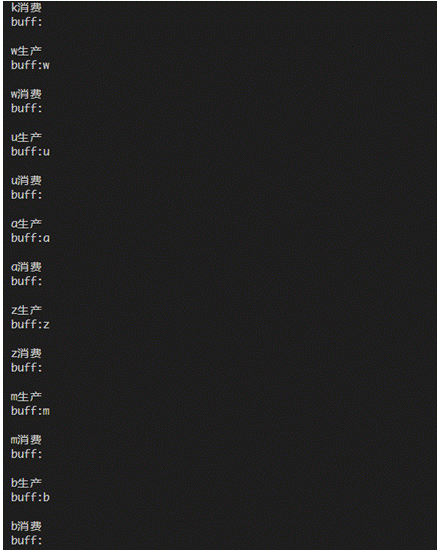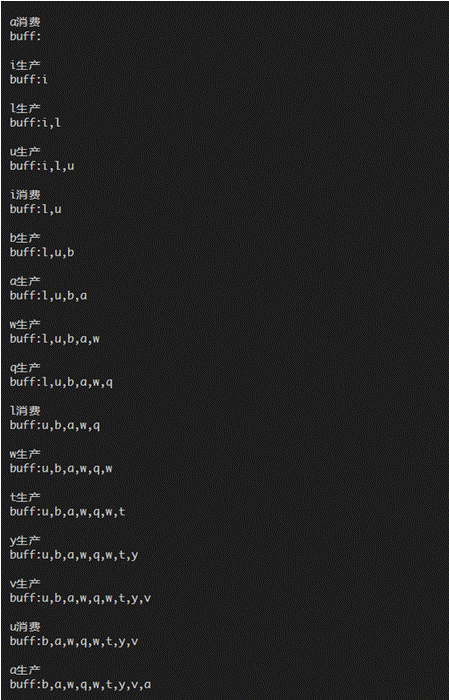Linux-信号量互斥
1. 消费者生产者问题
通过创建两个线程,一个代表生产者,另一个代表消费者,申请一段固定大小的内存区域表示缓冲区,向缓冲区末尾插入字符和取出字符来模拟生产消费的过程,
其中生产过程是随机生产一个小写字母放入缓冲区中,而且用nextin,nextout表示下一个要插入以及要取出的下标位置,方便下一次操作。
为了保证消费者线程在插入字符时,不被生产者线程堵塞,应该通过信号量机制防止此情况发生,设置三个信号量:
mutex::初始值为1,该信号量作用为控制一次只有一个线程可以访问缓冲区,保证消费过程和生产过程始终互斥。
empyt:初始值为缓冲区大小,每生产一次该信号量就减1,每消费一次该信号量就加1,当缓冲区已满时,该信号量会减小到0,这样在生产者线程开头的
sem_wait(&empty)就会堵塞生产过程,保证缓冲区已满时不再进行生产。
full:初始值为0,每消费一次该信号量就减1,每生产一次该信号量就加1,当缓冲区为空时,在消费者线程开头的sem_wait(&full)就会堵塞消费过程,保证缓冲区为空时不再进行消费。
2.代码如下:
1
2
3
4
5
6
7
8
9
10
11
12
13
14
15
16
17
18
19
20
21
22
23
24
25
26
27
28
29
30
31
32
33
34
35
36
37
38
39
40
41
42
43
44
45
46
47
48
49
50
51
52
53
54
55
56
57
58
59
60
61
62
63
64
65
66
67
68
69
70
71
72
73
74
75
76
77
78
79
80
81
82
83
84
85
86
87
88
89
90
91
92
93
94
#include <unistd.h>
#include <semaphore.h>
#include <stdio.h>
#include <pthread.h>
#include <stdlib.h>
#define N 10
char buff[N];
int count, nextin, nextout;
sem_t mutex;
sem_t empty;
sem_t full;
int speed_producer = 1, speed_consumer = 4;
void init() {
srand(time(NULL));
sem_init(&mutex, 0, 1);
sem_init(&empty, 0, N);
sem_init(&full, 0, 0);
nextin = 0;
nextout = 0;
count = 0;
}
void show() {
int j = count, i = nextout;
printf("buff:");
while (j--)
{
printf("%c", buff[i]);
i++;
i %= N;
if (j != 0)
{
printf(",");
}
}
printf("\n\n");
}
void *producerThread() {
while (1)
{
sem_wait(&empty);
sem_wait(&mutex);
buff[nextin] = 'a' + rand()%26;
printf("%c生产\n", buff[nextin]);
nextin++;
nextin %= N;
count++;
show();
sem_post(&mutex);
sem_post(&full);
sleep(speed_producer);
}
}
void *consumerThread() {
while (1)
{
sem_wait(&full);
sem_wait(&mutex);
printf("%c消费\n", buff[nextout]);
nextout++;
nextout %= N;
count--;
show();
sem_post(&mutex);
sem_post(&empty);
sleep(speed_consumer);
}
}
int main() {
pthread_t producer, consumer;
init();
pthread_create(&producer, NULL, producerThread, NULL);
pthread_create(&consumer, NULL, consumerThread, NULL);
pthread_join(producer, NULL);
pthread_join(consumer, NULL);
sem_destroy(&mutex);
sem_destroy(&empty);
sem_destroy(&full);
exit(0);
}
通过调整两个线程的延时快慢,speed_producer或者speed_consumer越大表示延时越长,速度越慢,修改这两个值即可得到不同运行效果。
运行输出解释:每次执行完生产与消费过程,程序将输出缓冲区当前所有不为空的字符
1
* 当speed_consumer与speed_producer均为1,或者speed_consumer大于speed_producer时,结果均为生产一个消费一个,缓冲区始终不满。

当speed_consumer为4,speed_producer均为1,每1秒生产一个字符,每4秒消费一个字符,因此缓冲区会逐渐填满。

3. 实验总结
- 掌握多线程编程方法,了解程序创建多线程的方法的原理。
- 通过运用信号量机制进行线程互斥,对临界区原理有了进一步的认识,并且对消费者生产者问题有了进一步的理解。
